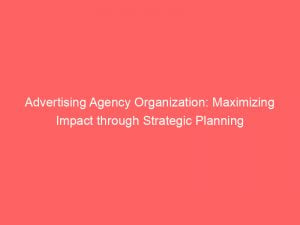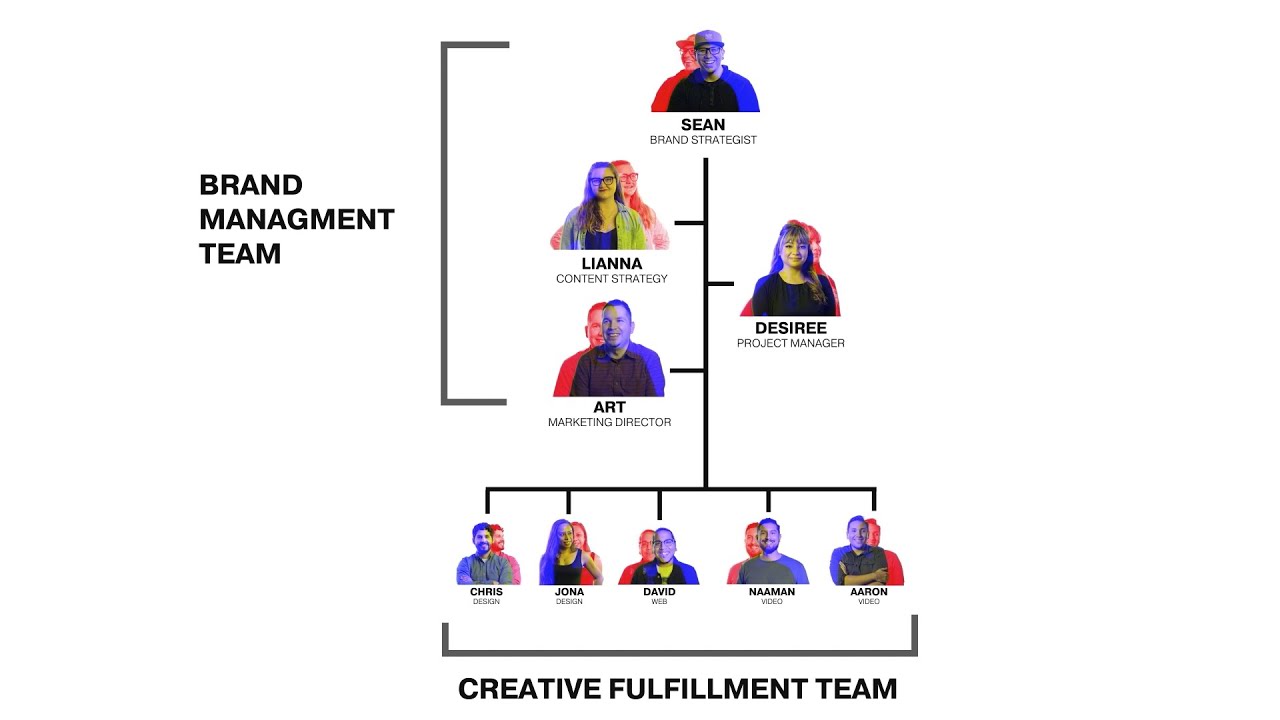In today’s fast-paced world, where effective communication and organization are the keys to success, advertising agencies stand at the forefront of innovation.
With an array of teams working together to create captivating campaigns, staying on top of tasks and connecting with clients becomes paramount.
Enter AgencyAnalytics, the ultimate solution for streamlining workflows, improving communication, and revolutionizing client interaction in the advertisingagency organization.
Discover how this game-changing tool brings harmony to the dynamic world of advertising.
New optimization tactics included — stay ahead.
| Item | Details |
|---|---|
| Topic | Advertising Agency Organization: Maximizing Impact through Strategic Planning |
| Category | Ads |
| Key takeaway | In today's fast-paced world, where effective communication and organization are the keys to success, advertising agencies stand at the forefront of innovation. |
| Last updated | December 29, 2025 |
agency-organization">agencyadvertising agency organization
An advertising agency organization typically consists of various teams and roles that work together to deliver effective campaigns for clients.
These teams include the account services team, creative team, media specialists, senior management team, and account planners.
The structure of the agency can be traditional, pod, matrix, flat, or freelance/collective.
The organization is usually hierarchical, with clear roles and responsibilities, and a top-down management approach.
However, there are potential challenges such as role confusion, power struggles, and increased communication overhead.
In a flat model, direct communication and inclusivity are emphasized, while a freelance/collective model offers flexibility and scalability.
Effective communication and direct interaction between specialists and clients are crucial for success.
Tools like AgencyAnalytics can streamline workflows, improve reporting and success communication, and integrate and manage agency tasks.
Overall, an advertising agency organization aims to deliver impactful campaigns through collaboration, effective communication, and the utilization of specialized teams and tools.Key Points:
- An advertising agency organization consists of various teams and roles that collaborate to create successful campaigns.
- The teams include account services, creative, media specialists, senior management, and account planners.
- The agency’s structure can be traditional, pod, matrix, flat, or freelance/collective.
- The organization is usually hierarchical with defined roles and a top-down management approach.
- Challenges may arise, including role confusion, power struggles, and increased communication overhead.
- Different models, such as flat or freelance, prioritize direct communication and flexibility.
Check this out:
💡 Did You Know?
1. The first known advertising agency, Volney B. Palmer Advertising Agency, was established in Philadelphia in 1841. It revolutionized the way advertising was handled by offering comprehensive services like media planning, copywriting, and space buying.
2. The practice of using brand logos in advertising can be traced back to ancient Egypt. Merchants would engrave their unique symbols onto clay seals, which were then used to mark their products and signify a sense of trust and quality.
3. The world’s first advertising agency organization, the American Association of Advertising Agencies (4A’s), was founded in 1917. Its primary goal was to promote ethical business practices and protect the interests of advertising agencies in the rapidly growing industry.
4. The phrase “sex sells” became widely popularized in the 1920s when Edward Louis Bernays, known as the father of public relations, strategically used sexual imagery to promote products. He believed that by tapping into psychological desires, advertisers could create stronger emotional connections with consumers.
5. The longest-running advertising campaign in history is for the Pears soap brand. Started in 1807, it featured a painting by Sir John Everett Millais called “Bubbles.” The iconic image of a young boy blowing soap bubbles became synonymous with cleanliness and purity, and the campaign ran for over a century.
Account Services Team
The account services team has a vital role within an advertising agency organization. This team is responsible for maintaining client relationships, managing clients’ accounts, and ensuring effective campaign execution. It consists of various roles, including:
Account directors: These individuals lead the account services team and oversee its operations. They serve as the main point of contact between the agency and the client. Account directors are responsible for developing strategies, managing budgets, and ensuring client satisfaction.
Account executives: They are tasked with executing daily activities related to client accounts. Account executives work closely with both the account director and the client to ensure smooth campaign operation, meeting deadlines, and achieving objectives.
Assistant account executives: They provide support to the account executives and assist with administrative tasks.
Account planners: These professionals are responsible for conducting market research, analyzing consumer behavior, and developing strategic insights. They significantly contribute to the planning and development of effective advertising campaigns by providing valuable consumer insights and ensuring that campaigns are appropriately targeted.
Creative Team
The creative team within an advertising agency is responsible for developing the visual and written content that forms the basis of advertising campaigns. This team consists of copywriters, designers, and a creative director.
Copywriters are responsible for creating compelling and persuasive written content for advertisements. They work closely with the account services team to understand the client’s objectives and target audience and then craft messaging that effectively communicates the client’s message.
Designers play a crucial role in bringing the visuals of the campaign to life. They create eye-catching and visually appealing designs that align with the client’s brand and messaging. Designers work closely with the copywriters to ensure that the visual and written elements of the campaign are cohesive and impactful.
The creative director acts as the leader of the creative team. They oversee the development of all creative content, ensuring that it aligns with the client’s objectives and brand identity. The creative director also provides guidance and direction to the copywriters and designers, ensuring that their work meets the highest standards of creativity and effectiveness.
Media Specialists
Media specialists play a crucial role in the success of advertising campaigns by identifying and implementing effective media strategies. They have in-depth knowledge of various media channels, including television, radio, print, digital, and social media.
Media specialists collaborate with the account services team to develop media plans that will effectively reach the target audience. They analyze market trends, audience demographics, and media consumption habits to inform their media recommendations. Media specialists also negotiate media buys, ensuring that the client’s budget is used efficiently.
In the ever-evolving world of media, media specialists stay up to date with the latest trends and technologies. They understand how to leverage various media platforms to maximize the impact of advertising campaigns.
Ultimately, by working closely with the account services team and the creative team, media specialists contribute to the strategic planning and execution of successful advertising campaigns.
Senior Management Team
The senior management team plays a crucial role in the organization of an advertising agency. Comprised of top-level executives, such as the CEO or president, vice presidents, and directors, this team provides overall direction, sets goals, and makes critical decisions that shape the agency’s operations and success.
The CEO or president is responsible for overseeing the agency’s overall performance, ensuring its competitiveness in the industry. They develop long-term strategies, manage financial aspects, and establish the agency’s reputation. Moreover, the CEO or president acts as the external face of the agency, representing it to clients, partners, and the media.
Vice presidents and directors, on the other hand, have specific responsibilities within the agency’s operations, which can include account services, creative, media, or finance. They provide leadership and guidance to their respective teams, ensuring alignment with the agency’s overall goals. Additionally, vice presidents and directors collaborate with the senior management team to develop and implement strategic initiatives.
Having clear roles and responsibilities within the senior management team is crucial to effective decision-making and smooth operations. The collective expertise and experience of this team contribute to the overall success of the advertising agency organization.
FAQ
What is the organization of an advertising agency?
The organization of an advertising agency is structured into various divisions based on their expertise. The creative, production, client services, and finance divisions are led by department heads, such as an Advertising Manager or Director of Advertising. These divisions house teams of specialists who excel in their respective fields, collaborating and leveraging their skills to deliver impactful advertising campaigns to clients. This structure allows for efficient coordination and teamwork, ensuring that every aspect of the advertising process is handled expertly and effectively.
What is the organizational structure of an agency?
In an agency’s organizational structure, the CEO or president serves as the head, guiding the overall direction and strategy. Below them, there are typically VPs and directors responsible for different departments, ensuring smooth operations and effective management. These departmental hierarchies allow for clear lines of authority and streamlined decision-making processes, facilitating efficient collaboration and goal achievement within the agency.
What is Organisation advertising?
Organizational advertising focuses on cultivating the image and reputation of an organization rather than directly boosting sales. It aims to shape public perception by highlighting the organization’s values, promoting its philosophy, and advocating its ideas. This type of advertising often involves initiatives such as practicing charity and goodwill, which further enhance the organization’s reputation and brand image. By prioritizing the establishment of a positive public perception, organizational advertising plays a crucial role in building long-term trust and loyalty among the target audience.
What is the structure of a full service ad agency?
A full-service ad agency typically operates with a structured framework that encompasses various departments and roles. At its core is a collaborative creative team, composed of copywriters who carefully craft the right messaging and designers or art directors who bring those messages to life visually. This team works closely together to ensure the development of compelling and visually engaging deliverables. Additionally, a crucial component is the production department, responsible for taking these creative assets and overseeing their final stage, ensuring they are ready for distribution or implementation. Through this well-established structure, a full-service ad agency can efficiently and effectively create impactful advertising campaigns for their clients.
Programmatic Advertising • Self-Serve DSP Platform • Advertising Platform for Marketers











